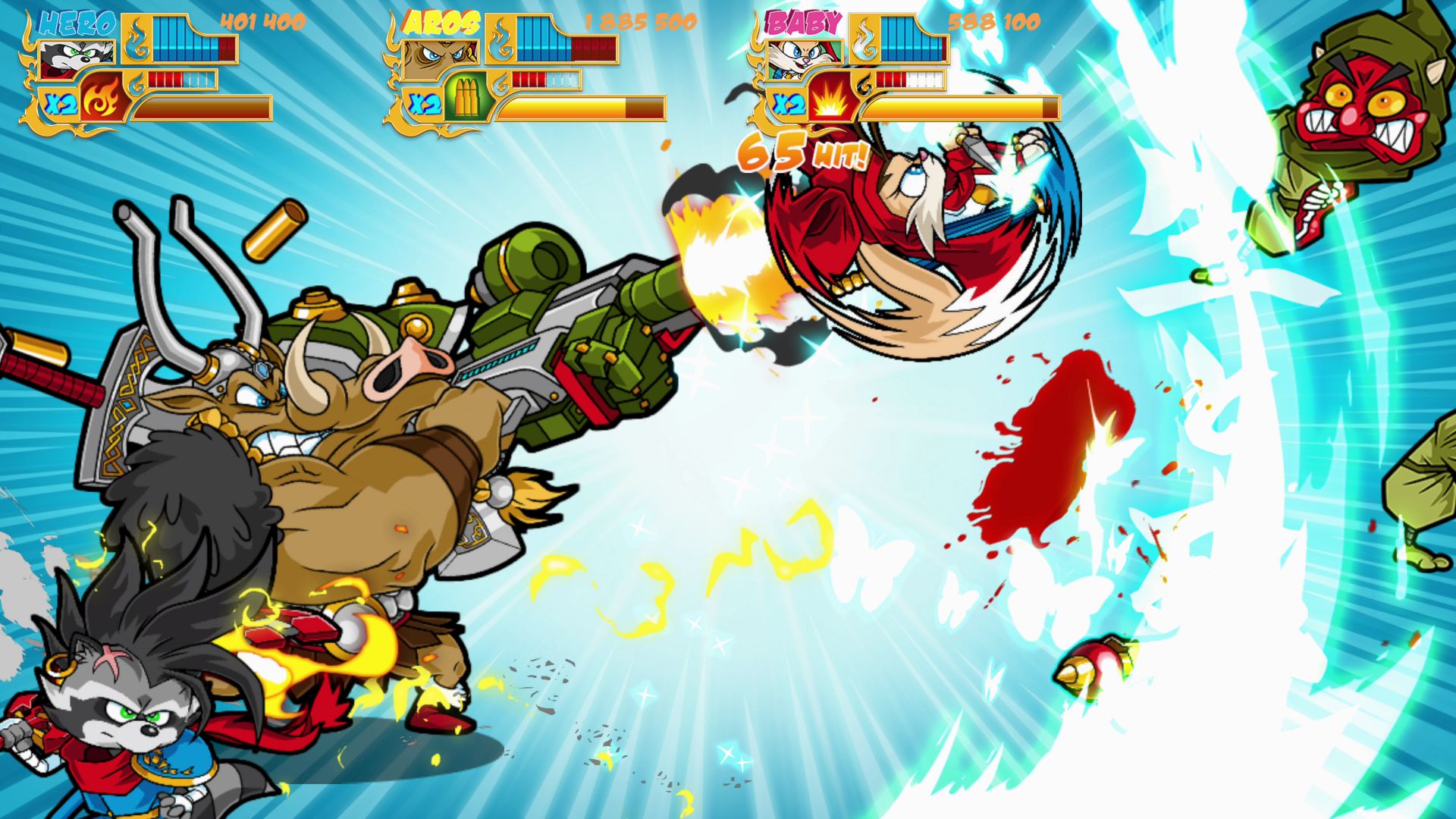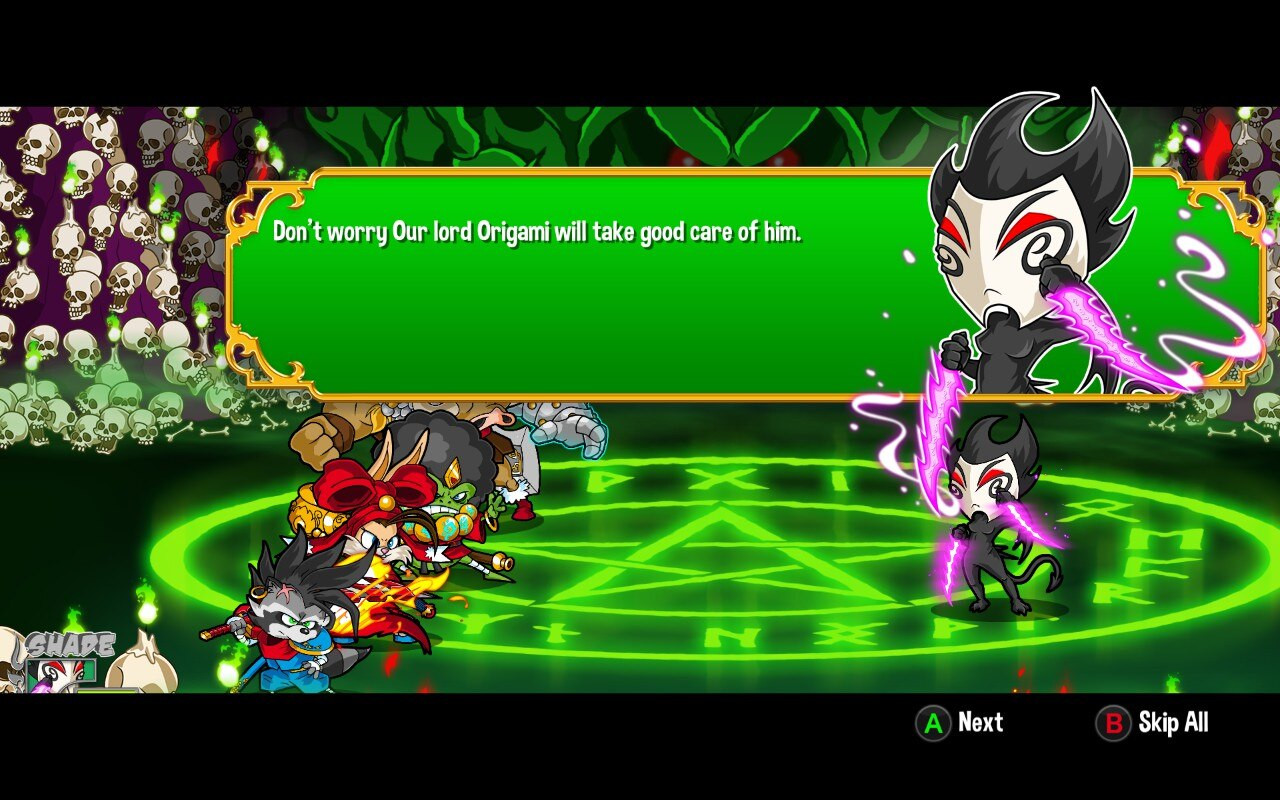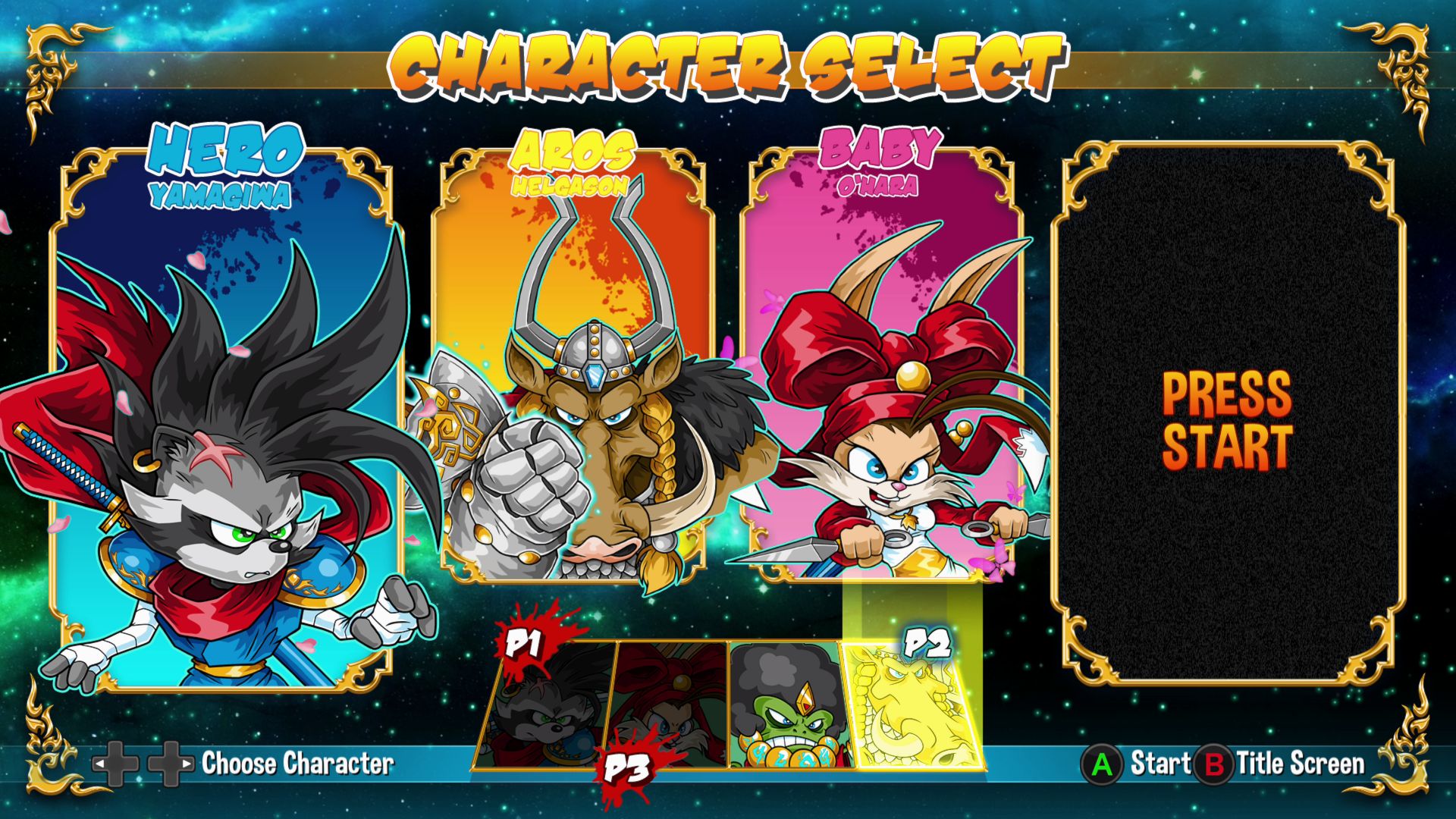

Things have been great for cooperative beat ‘em ups lately, with games like TMNT: Shredder’s Revenge, River City Girls 2, Final Vendetta, and Kung Fury: Street Rage – Ultimate Edition all entertaining audiences with their unique approaches to the genre. Jitsu Squad from Tanuki Creative Studio and ININ Games has its own distinct style, combining flashy fighting game-style effects, humanoid animals, and 4-player local co-op into one shiny package. Jitsu wait, dear reader, and we’ll tell you how well it all turns out.
Jitsu Squad plays a fully voiced cinematic at the start of the game and between each of its eight levels. Non-voiced in-game cinematics also play at key points in each level. The story, basically, involves four feudal heroes who have been cursed by an evil sorcerer, turning them into furries, I mean, animals. That evil sorcerer, Origami, wants a legendary stone so he can take over the world or something. The protagonists have been whisked away by Master Ramen, an owl, allowing them to fight for good instead of being enslaved by Origami.

The story seems to aim for a Saturday morning cartoon vibe, but I found it more puerile than entertaining. The heroes’ dialog mostly consists of boasts and posturing. While some of them have backstory beefs with certain bosses, none of them feels like a real character with a personality (other than “trying too hard” ‘tude). The voice acting is some of the worst in recent memory, which doesn’t help.
The other sticking point for me is the abundance of errors in the written text. For instance, dozens of commas are missing throughout the script. The only time commas are used is when a semicolon is needed! Admittedly, this is a game developed in Europe, where commas are used more scarcely, but the lack of commas here goes beyond that, and it constantly pulled me out of the game.

At the start of the game, players will choose among four heroes (a fifth is planned as DLC). Hero is a raccoon who serves as an all-around character, Baby is rabbit who moves quickly and throws kunai blades, Jazz is an afro-wearing frog who uses magic and specializes in air combos, and Aros is a tank-like boar. They’re all visually distinct and play sufficiently differently from one another.
Unlike many newer beat ‘em ups, Jitsu Squad relies on one primary attack button for standard attacks and combos. There is a button for weapon attacks, but weapons are limited use and don’t carry over between stages, so they’re really for bosses or tough moments rather than mixing into normal combos. That said, the protagonists do gain special moves over the course of the game that are mostly performed by combining the attack button with one of the four cardinal directions. These moves look cool, are fun to perform, and work with combos. It’s a matter of taste, but I can’t help wishing for a second attack button for making bread-and-butter combos.
Other attack options include a grab button for holds and throws (always welcome), a super button, and a transform button. Supers require a fully charged meter, so they can’t be used very often. Still, they fill the screen with amazing Marvel vs. Capcom-style visual effects, so they’re definitely a highlight. Transforming allows our animal characters to briefly transform into their human forms for extra damage.
Finally, each level has one or more assist items to find. When picked up, these will summon a guest character (such as Yooka and Laylee or Maximilian Dood) to deal a flashy, powerful attack to all on-screen enemies. The assists certainly dazzle the eyes, but the fact that they can’t be collected and saved for special occasions dramatically limits their usefulness. If you’ve already cleared the screen of enemies before finding the item, it gets wasted.
At present, Jitsu Squad offers a campaign with three difficulty levels, an unlockable tag team mode, and a practice mode. Each level consists of several interconnected areas followed by a boss. The bosses are all different animal bad guys such as a snide karasu tengu, a viper lady, and a white tiger. Most deliver fun challenges, though Shade, a boss who must be defeated multiple times in the last level, is a pain when playing solo.
The levels themselves are quite beautiful. Each area utilizes parallax scrolling for depth, and most areas have NPCs performing cute animations in the background too. That visual inventiveness doesn’t apply to the actual level design, however. Nearly every level is just a straight trip from left to right with nothing but fights in between. There’s no interactivity outside of breakable chests and rocks, no collectables to seek, and no variation in level layouts. Classic beat ‘em ups like Double Dragon broke things up with climbing, vertical scrolling, narrow sections, wall hazards to avoid, and more. The recent Shredder’s Revenge also does a great job of mixing up the way that levels play and feel. The only one that feels any different here is a lone surfing level late in the game. That’s a welcome diversion, but the other areas blend together and become repetitive after a while. Enemy repetition is another issue that could’ve been alleviated by adding more palette-swapped enemies (there are hardly any).
Thankfully, local co-op significantly lessens that feeling of repetition – with one big caveat. On the plus side, frantically fighting hordes of monsters is a joy with 2-4 players. The chaotic visual style and effects suit team play quite well. Jitsu Squad doesn’t have specific co-op moves, but the game really is a bit easier (especially at bosses) with a few friends watching your back. Beating the game will unlock the Tag Team option for Story Mode, allowing two players to pick their own pairs of characters and swap them out at will.
The one downside to Jitsu Squad’s co-op is that this game does NOT let players drop out. After starting a game, whether you’re playing solo or with four players, you can’t change characters or players without starting the game over. Most games would let the user reconfirm how many players are present when loading up a save file, but not this one. If you started with four players, you’ll have to either finish with four or just start over – not very convenient.
When we interviewed Jitsu Squad’s developers, their love for beat ‘em ups was obvious. Mixing beat ‘em ups with fighting game elements (including the Marvel vs. Capcom-style announcer) has rarely been done as well as it has here. I didn’t fall in love with this one, alas, mostly because of the repetitive level design, lack of enemy variety, and annoying story. Still, the colorful visuals, stunning effects, and rocking soundtrack by composer Sebastien Romero, not to mention 4 player local co-op, certainly make Jitsu Squad worth a playthrough – preferably with a friend or three. We’ll see how the promised DLC livens the game up whenever it finally comes around.
Jitsu Squad sells for $29.99 digitally on Xbox, PlayStation, and Switch. Physical PlayStation 4, PlayStation 5, and Switch versions are available for $29.99 each. The catchy soundtrack sells for $9.49 on Amazon Music and other storefronts.
Xbox and Steam codes were provided by the publisher and developer for this review.